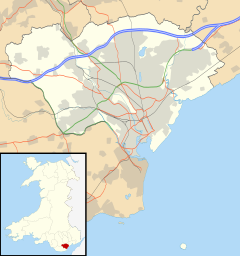Cardiff city centre
Cardiff City Centre
|
|
|---|---|
 The Hayes, Cardiff with Cardiff Central Library (right) |
|
| Cardiff City Centre shown within Cardiff | |
| Principal area | |
| Ceremonial county | |
| Country | Wales |
| Sovereign state | United Kingdom |
| Post town | CARDIFF |
| Postcode district | CF10; CF11; CF24 |
| Dialling code | 029 |
| Police | South Wales |
| Fire | South Wales |
| Ambulance | Welsh |
| EU Parliament | Wales |
| UK Parliament | |
| Welsh Assembly | |
Cardiff city centre (Welsh: Canol Dinas Caerdydd) is the city centre and central business district of Cardiff, Wales. The area is tightly bound by the River Taff to the west, the Civic Centre to the north and railway lines and two railway stations – Central and Queen Street – to the south and east respectively. Cardiff became a city in 1905.
The city centre in Cardiff consists of principal shopping streets: Queen Street, St. Mary's Street and the Hayes, as well as large shopping centres, and numerous arcades and lanes that house some smaller, specialized shops and boutiques.
The city centre has undergone a number of redevelopment projects, including St. David's 2, which extended the shopping district southwards, creating 100 new stores and a flagship John Lewis, the only branch in Wales and the largest outside London. Compared to nearby cities, the new St David's Centre has more retail space than the whole of Newport or Swansea.
In 2008–9, the annual of shoppers was 55 million, and is expected to have risen to 66 million by 2009–10. Cardiff is the sixth most successful shopping destination in the United Kingdom – behind London, Glasgow, Birmingham, Manchester and Liverpool.
Cardiff was granted city status by Edward VII in 1905.
In the 1960s, planners described Cardiff city centre as "worn out, inconvenient, drab and dangerous". The centre had escaped the extensive wartime bomb damage inflicted on other cities, so little redevelopment took place in the 1950s and 1960s. The Buchanan Plan of 1964 envisaged a highly ambitious extended city centre, crossed with urban motorways. The council scrapped the proposed motorway network and focused on the small commercial core of the city; its proposed redevelopment scheme, in partnership with a private developer, would have seen almost all of the city centre (except St Mary Street and Working Street) demolished, replaced by modernist office towers of up to 21 storeys and pedestrianised decks linking multi‑storey car parks to covered shopping malls.
...
Wikipedia

